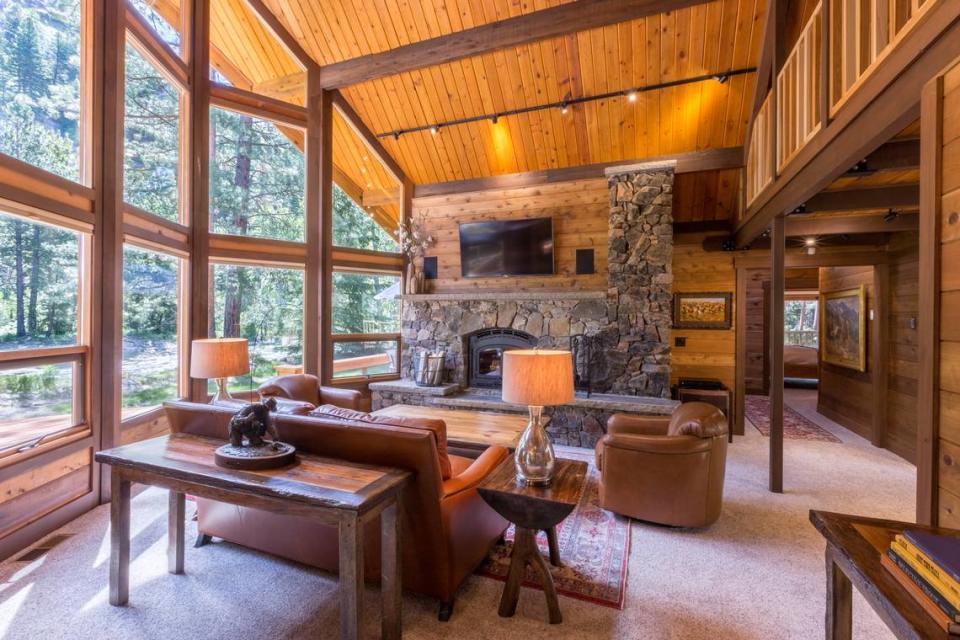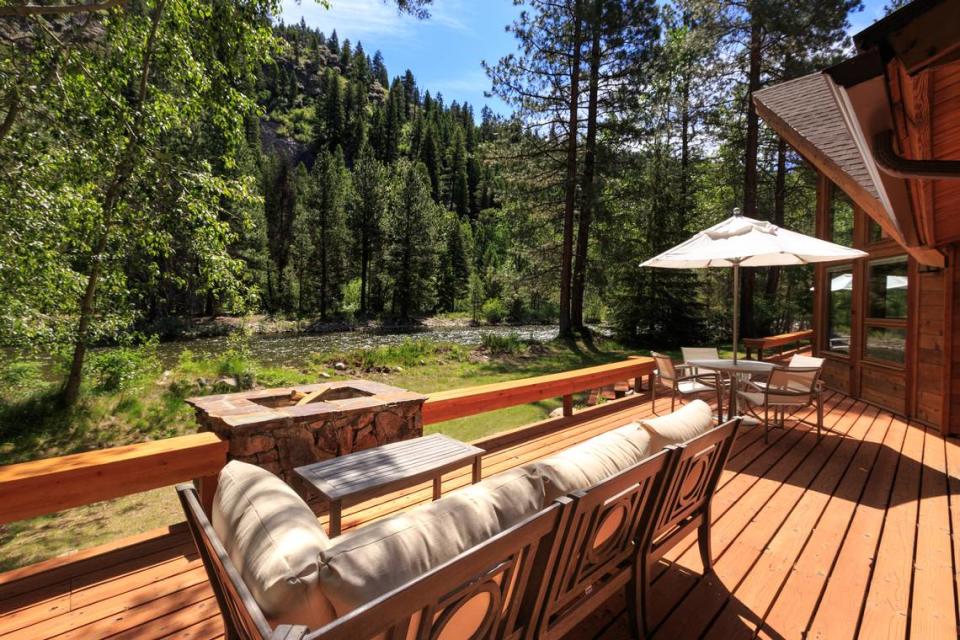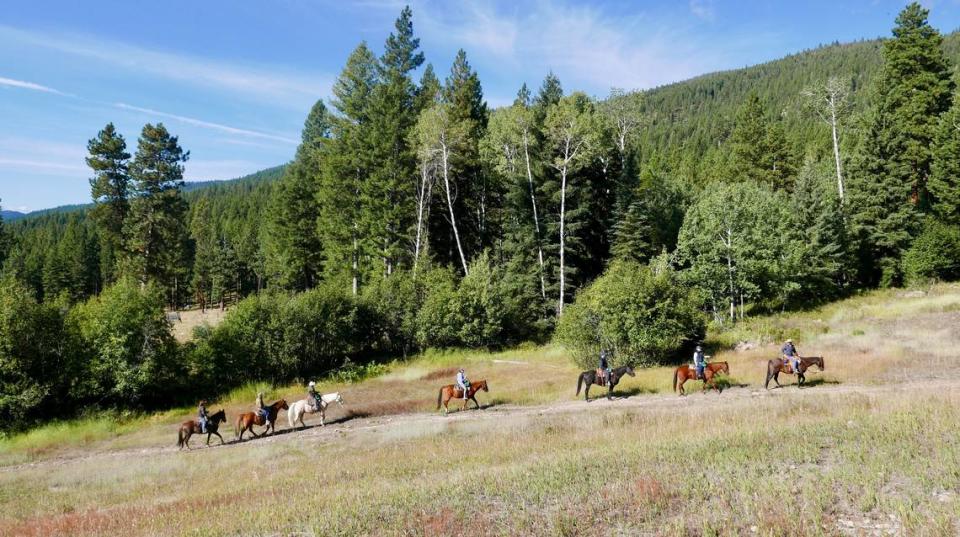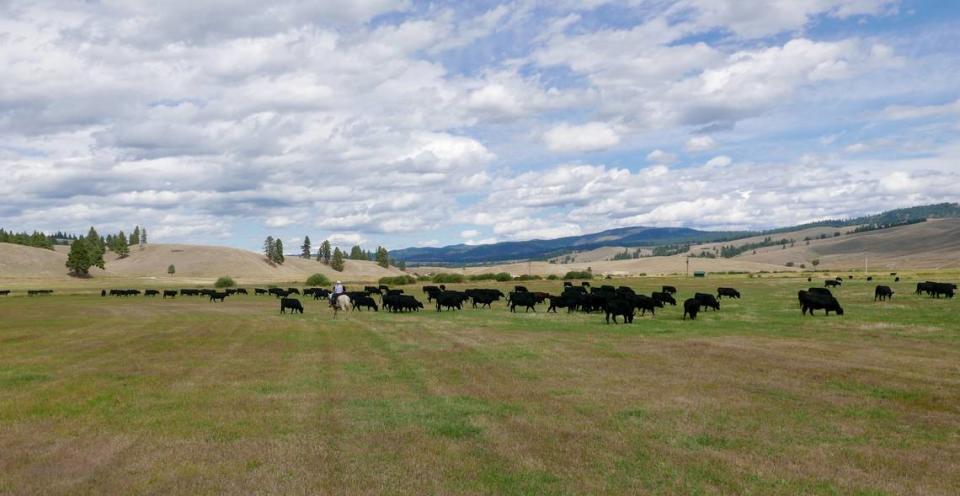Writer Eric Barton takes us on an adventure to a place where cattle, and Floridians, roam
The cowboy pulls the reins of Missouri Fox Trotter with deliberate yanks left and right, sending his horse into a figure-eight-shaped trot across the grass, a display of skill that shows years in the saddle. He’s retired career military, taking no trouble from his horse, and he tells stories about past cattle drives in skies choked with wildfire smoke and in the muddy fields of spring snowmelt.
Like me, though, the cowboy, as I’ve named him, is merely a tourist here on a Montana ranch, paying for the privilege to become a working cowboy for the day. I pull up alongside him and tell him that I’ve heard a rumor that he’s done hundreds of these drives.
“I’ve been on a few,” he says with practiced Southern modesty. “But where we’re going today, it’s not easy.” I ask what he means, and the cowboy continues in a voice that’s like he’s telling campfire ghost stories. “I’ve been thrown from my horse here, three times. Twice over, and once under. It’s been a while, but if it’s going to happen again, it’s here.” And then he darts off, joining the others by the barn.
It’s an ominous way to begin our cattle drive, but it’s also entirely appropriate. We’ve come here to the ultra-luxe Triple Creek Ranch in part to be lavished in spa treatments, a practiced casual-yet-attentive service and meals worthy of James Beard awards. But more than anything, we’ve come to herd cattle, to pretend to be cowpokes for a day. We learn quickly that this isn’t playtime, that we will actually work – and get in danger more than once.
This is a journey that’s common for many Floridians. Dude ranches and the upscale ranches are frequented by Floridians in summer months, where we soak in cool mornings and scenery that looks straight from Westerns. While most, if not all, ranches closed for the pandemic, there’s hope Floridians will return in strong numbers -- it would be hard to plan a better social-distancing vacation than on a ranch with cabins spread out in the forest.

Among the Western spreads Floridians frequent, Triple Creek Ranch is a distinguished Relais & Châteaux property and seeks to be among the West’s most luxurious. Its log and cedar cabins stretch out along 800 acres in the foothills of the Bitterroot Mountains. Views out the bay windows show nothing but forest. The service here is a practiced test in attention and casualness, where servers call everybody by first names while also remembering details from their pets’ names to how they take their elk steaks. The ranch pushed its typical April 20 season opening to June 1 for 2020, with the state government working on a rollback of its stay-at-home order.

The all-inclusive ranch provides activities like mountain biking and yoga and sapphire panning and archery lessons. But the highlight is the cattle drive, set up three times a week on nearby working cattle farms. Ten of us – three professional wranglers and seven guests of the resort – pile into pickups with horse trailers for the 20 minute drive to a nearby working ranch. It’s located over the Bitterroot River in the east side of the valley. With the rain clouds often caught by the jagged peaks of the mountains to the west, here we’re surrounded by arid hills so devoid of color they look from a distance like sand dunes, with only a rare scraggly tree. As the morning sun burns off the night’s chill, Triple Creek’s horse wranglers begin assigning us our rides.
Herd Mentality
Rose, the head wrangler, stands before us in fringed chaps, a western shirt, and a white Stetson-style hat. She walks through the plan. The herd is on a field with ample food for the cattle, but it gets boggy after rainstorms, exposing the animals to hoof rot. Today we will round them up, likely finding stragglers in the corners of the field, and drive them north into fresh, drier land.
Rose offers a warning, though. Drainage ditches crisscross the field, and their rocky, muddy, rutty banks often cause horses to drop to their knees. “If your horse falls, don’t get off,” she explains. “The safest place for you is on your horse.” That won’t happen to most of the horses, she says, but a couple of them aren’t as deft at crossing the streams. “You two should avoid the water,” she says, pointing at my wife and me.
Rose leads the way to the far side of the field and the back side of the herd. Here, we ride along the edge of the wide Bitterroot River, with its rapids catching the morning sun like a cascade of twinkly holiday lights. Rose splits us up into teams – she will lead the main assault on the herd from the center, while the others will hit the flanks.
Earlier that morning, a Texan who had previously been on the Triple Creek cattle drive, warned that a couple “city slickers” nearly wrecked her last drive; they did little work and instead just spent the time on horseback taking selfies. As two South Floridians with little saddle experience beyond an occasional ride on vacation, my wife and I worried that we might fit that category.
Julia, another Triple Creek wrangler, leads the two of us over to the herd’s right flank. Today is her first cattle drive for the resort, though she has wrangled cattle at her dad’s ranch since she first fit in a saddle. She looks just old enough to buy liquor, but she offers careful instruction, like a veteran schoolteacher, and she spurs her horse to action as deftly as the more seasoned wranglers. Julia explains that the cattle will naturally fear us as we get close, but we must be sure to cut left and right behind them in order to push them toward the herd. Failure will mean the cows might dart off, get caught up in barbed wire, stuck in a drainage ditch, or simply get lost.

“Giddup, cows! Giddup!” Julia yells in a singsong voice. The cows rise from their lazing positions and stop their grazing and begin heading off. But there are stragglers spread out in tall, boggy grass over what looks like maybe 10 acres, and Julia splits us up to drive them slowly toward the center of the field. My wife, on a slower horse, will be closest to the herd. Julia takes the center, and I’ll attack the far side.
As I angle my horse, Duke, left and right to get behind the errant cattle, I realize that we are actually, somehow, herding. The strays collect in a group and head toward the main herd, often slowing to test us, requiring us to come in close before they dart off with the others.
My group of nine cows moves steadily across the grassland until finally they stop dead. They’re on a peninsula of land between where two drainage ditches meet, a two-foot cliff all around them. I call out to Julia wondering what to do next, remembering the warning against crossing water. “Move ‘em forward,” she says. “They’ll know what to do.”

I kick both heels into Duke’s side, and he lurches toward the cows. Their bulbous black bodies crowd tight on the spit of land. Finally, one drops into the stream and climbs up the other bank toward the main herd. Another follows, then another, and finally the whole group is on the other side.
Suddenly, I find myself alone on the peninsula, a sharp drop down right and left. “If you pull back on the reins, your horse does have reverse,” one of the wranglers had joked with me earlier that morning. I pull back, and Duke deftly steps backward. Then, with a pull to the left, he spins in a circle before heading off toward a safe crossing.
“Good job!” Julia yells to us as we head toward the main herd, a moment of elation that would be the highlight of the trip.
Keeping it Together

The three of us take up our position on the right flank as Rose and her team push the main group toward a bottleneck, a single opening in the fence. It looks like we’ll get the whole group through safely, until suddenly something goes wrong.
Two of the tourist cowpokes in the center get a bit too ahead, and the entire herd begins a stampede. They’re running, and heading right for us.
Julia yells for my wife and I to take up our positions. If we let the cows get past us, the entire day will be lost. There simply won’t be enough time to finish the drive if we lose the herd back across the drainage ditches. We spur our horses forward, directly in the path of the stampede.
And then, just as Julia had said, the herd stops. The three of us cut left and right and advance slowly. The herd reverses its approach. A dust cloud kicks up in the dry land along the fence line as we push them toward the gate, across the highway, and into the new field. The cows spread out, their dark coats becoming stark dots on a field of brilliant greens, grazing again in a peaceful serenity.
We tie our horses under the shade of willow trees as the afternoon brings in warmer weather, the chill wind off the mountains still keeping it from becoming hot. We gather on the deck of a ranch house and eat a lunch prepared by Triple Creek – shrimp cocktail, muffuletta sandwiches, and salads dotted with huckleberries. And we tell stories about the drive.
“I thought we lost it,” Julia says with a laugh. “We were real close to losing the whole herd.”
After lunch, we push the cows deeper into the drier fields, our work far easier without the deep drainage ditches. With the herd in good grazing lands, we trot in formation back down the gravel road toward the barn, still telling our stories of the drive.
It’s easy to see why so many Floridians come all the way to western Montana. We were lavished with fine meals and good wine and spa treatments at the resort, and for many that might be enough. But then there was the exhilaration of learning how to rustle cattle, to save the drive from disaster, to actually become a cowboy, at least for one sunny morning.

